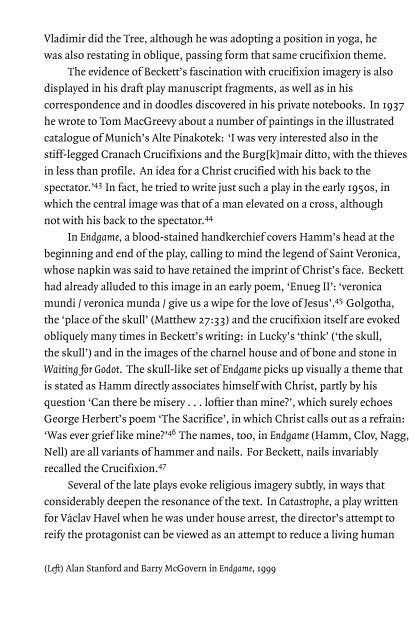Create successful ePaper yourself
Turn your PDF publications into a flip-book with our unique Google optimized e-Paper software.
Vladimir did the Tree, although he was adopting a position in yoga, he<br />
was also restating in oblique, passing form that same crucifixion theme.<br />
The evidence <strong>of</strong> <strong>Beckett</strong>’s fascination with crucifixion imagery is also<br />
displayed in his draft play manuscript fragments, as well as in his<br />
correspondence and in doodles discovered in his private notebooks. In 1937<br />
he wrote to Tom MacGreevy about a number <strong>of</strong> paintings in the illustrated<br />
catalogue <strong>of</strong> Munich’s Alte Pinakotek: ‘I was very interested also in the<br />
stiff-legged Cranach Crucifixions and the Burg[k]mair ditto, with the thieves<br />
in less than pr<strong>of</strong>ile. An idea for a Christ crucified with his back to the<br />
spectator.’ 43 In fact, he tried to write just such a play in the early 1950s, in<br />
which the central image was that <strong>of</strong> a man elevated on a cross, although<br />
not with his back to the spectator. 44<br />
In Endgame, a blood-stained handkerchief covers Hamm’s head at the<br />
beginning and end <strong>of</strong> the play, calling to mind the legend <strong>of</strong> Saint Veronica,<br />
whose napkin was said to have retained the imprint <strong>of</strong> Christ’s face. <strong>Beckett</strong><br />
had already alluded to this image in an early poem, ‘Enueg II’: ‘veronica<br />
mundi / veronica munda / give us a wipe for the love <strong>of</strong> Jesus’. 45 Golgotha,<br />
the ‘place <strong>of</strong> the skull’ (Matthew 27:33) and the crucifixion itself are evoked<br />
obliquely many times in <strong>Beckett</strong>’s writing: in Lucky’s ‘think’ (‘the skull,<br />
the skull’) and in the images <strong>of</strong> the charnel house and <strong>of</strong> bone and stone in<br />
Waiting for Godot. The skull-like set <strong>of</strong> Endgame picks up visually a theme that<br />
is stated as Hamm directly associates himself with Christ, partly by his<br />
question ‘Can there be misery...l<strong>of</strong>tier than mine?’, which surely echoes<br />
George Herbert’s poem ‘The Sacrifice’, in which Christ calls out as a refrain:<br />
‘Was ever grief like mine?’ 46 The names, too, in Endgame (Hamm, Clov, Nagg,<br />
Nell) are all variants <strong>of</strong> hammer and nails. For <strong>Beckett</strong>, nails invariably<br />
recalled the Crucifixion. 47<br />
Several <strong>of</strong> the late plays evoke religious imagery subtly, in ways that<br />
considerably deepen the resonance <strong>of</strong> the text. In Catastrophe, a play written<br />
for Václav Havel when he was under house arrest, the director’s attempt to<br />
reify the protagonist can be viewed as an attempt to reduce a living human<br />
(Left) Alan Stanford and Barry McGovern in Endgame, 1999<br />
IMAGES OF BECKETT 65


